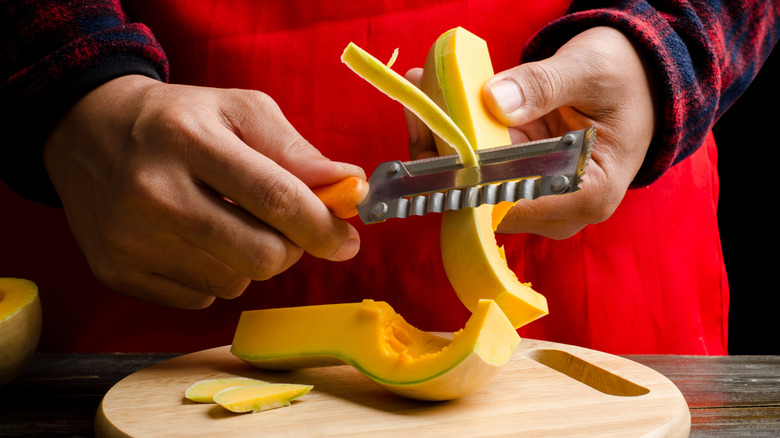Why You Should Always Over-Peel Butternut Squash For The Silkiest Results
We may receive a commission on purchases made from links.
Butternut squash is a powerhouse ingredient. You can do just about anything with it, from making a creamy, decadent soup to slicing it up and roasting it with maple syrup for a comforting side dish. You can even slice it lengthwise into thin strips and use it as a pasta substitute for lasagna or simply halve it, roast it, and serve it as a creamy, nutty schmear for toast or bagels. But while coming up with ways to use that squash that you simply couldn't pass up in the grocery store is easy, the way you prep the squash to cook it requires a bit of attention to be sure that you get the silkiest, smoothest results possible.
Prepping it is fairly straightforward; you'll just peel it, then chop it or slice it, depending on the recipe. But peeling it isn't as simple as it sounds. If you're familiar with the saying, "Less is more," forget it — at least while you are peeling squash. When it comes to butternut squash, it's better to peel more than you need. The skin of butternut squash is technically edible, but as the squash cooks, it becomes very fibrous and tough, which makes the squash not only difficult to eat but creates an unpleasant mouthfeel. So, peel away until the under layer of the skin is completely removed, including any pale flesh hidden by the skin. You want to only have the vibrant, orange-fleshed squash to cook with.
Choosing the right tool makes a world of difference
No well-equipped kitchen should be without at least one vegetable peeler. They're not only key for peeling veggies with ease, but they come in handy for the most unexpected reasons. You can always use a knife to peel your squash — this option will allow you to remove thick layers of skin so peeling your butternut squash is a quick task. This option, however, lacks the control you get from a vegetable peeler, especially as you work your way down the long stalk of the squash and around the curve of the bulbous end.
Vegetable peelers come in many shapes and sizes. For instance, Y-peelers like Gourmet Easy's peeler have long handles that split into two tips at one end with horizontal blades connecting the two tips. A swivel peeler, such as Spring Chef's veggie peeler, is another common type that has a long handle with a double blade attached vertically along one end, but it also swivels as needed while you are peeling. While they will both work well with butternut squash, a Y-peeler gives you the best leverage when peeling vegetables like butternut squash with a hard exterior.
To peel your squash, cut off both ends of the squash and set the flat bottom of the large, bulbous end on a cutting board. Working downward and around the curve of the bulb, being careful to keep your fingers clear of the blade, peel away the skin until the exposed flesh is a solid orange without any long fibrous tissue showing. Once you've got your squash peeled and ready to go, you'll be ready to cook and enjoy the silkiest squash you've ever eaten.

